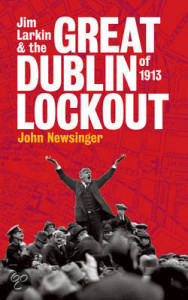 Reviewer: Wouter van Dijk
Reviewer: Wouter van DijkJim Larkin & the Great Dublin Lockout of 1913, John Newsinger
Bookmarks Publications, London 2013
ISBN: 978 1 909026 37 7
Paperback, with notes
80 pages
£4 / €8,49
The story of Ireland’s greatest industrial struggle
After his 2004 book Rebel City. Larkin, Connolly and the Dublin Labour Movement John Newsinger, on account of the 100-year anniversary of the Dublin Lockout of 1913, returned to the streets of Ireland’s capital to give a concise overview of what was the country’s greatest industrial struggle of all times. For those unfamiliar with the subject, the 1913 Dublin Lockout was a conflict between the Irish Transport and General Workers Union (ITGWU) led by Jim Larkin and most of the Dublin employers under leadership of industrial magnate William Martin Murphy, backed by the authorities and the church. The ITGWU was a relatively young union founded by Larkin and based on the assumption that only workers’ action in the form of general strikes could force Irish employers to raise workmen’s wages instead of careful negotiations led by union officials. Their tactics of solidarity action in strikes and blacklegging tainted goods to support striking workers in other branches proved successful and by 1913 the ITGWU had a large membership base in the city. Murphy by this time decided to crush militant unionism once and for all, and therefore its most prominent standard bearer, the ITGWU, had to be destroyed. After having assured himself from the approval of the governments forces, from august 1913 onwards, starting with the tramway company Murphy owned, every employee who was a member of the ITGWU was locked out of their job. The other employers in the city were quick to follow Murphy’s lead firing union members from factories, the coal industry, carters and dock workers. In response the ITGWU called a general strike and by the end of September some 25.000 people were locked out by around 400 employers. After nearly six months of demonstrations, police attacks and starvation, the strikers were eventually forced to return to give in and returned to work where they could.
Newsinger, professor of History at Bath Spa University, tells the story of the dispute in a very succinct, but passionate way. In a little less than eighty pages he manages to address Larkin’s rise to prominence in the Irish labour movement, the origins of the ITGWU and its politics and the role of the Irish Worker newspaper in the struggle, besides presenting a clear overview over the course of the conflict. The fact that the government preferred the starvation of thousands of its citizens fighting for minimum means of subsistence over enforcing its employees to grant their employees a reasonable livelihood says enough of the cruel part it played in the defeat of the union. To preserve the existing status quo the government didn’t even shun beating people participating in peaceful demonstrations to death. If this was not enough already, the Roman Catholic Church also joined in the fray. When the ITGWU prepared the leave of union members’ children for a holiday at host families in England, the Church intervened and organized huge mobs to prevent the children from leaving in the harbor. The Church rather saw the children die of starvation than to let them go to ‘heretic’ protestant families in England, as the newspaper The Irish Worker remarked. That these British families were fellow Christians was of course irrelevant.
Even against these enormous odds the union could have won, Newsinger argues. The only chance of success of the Dublin workers lay in solidarity action of British unions. When Dublin goods were ‘blacked’ in the rest of the United Kingdom the employers had to give in to prevent their businesses going down. The fatal mistake Larkin made was that he trusted in the leftwing official in the unions to carry the resolution that provided this at the great Trade Union Congress in December 1913. What he did not saw through was the interest many of the fulltime British trade union officials had in a defeat of the ITGWU. A victory of Larkin and his followers would bring a wave of labour militancy and unrest to Britain, and this was not favorable for their position and the more than lukewarm relations many of them maintained with the leaders of British industry. Newsinger states that if Larkin and Connolly, his lieutenant in the struggle at the time, had focused on direct action of the rank and file of the unions, their leaders would have been forced to legitimate their solidary strikes or blacking actions afterwards, to maintain at least a semblance of authority. This was not to be, and without solidary action the ITGWU was left on its own to go down to defeat. In March 1913 the workers gradually went back to work and the ITGWU was licking its wounds, defeated but not destroyed.
With his gripping style Newsinger leaves no doubt on which side he stands, and that is very refreshing when most of the time authors get bogged down in a never-ending endeavour to appear as impartial as possible. One of the benefits of hindsight is that in some cases in history, it becomes very clear who was ‘wrong’ and who was ‘right’. Newsinger’s vigorous argument shows that the Dublin Lockout of 1913 is a vivid example that history is not always written by the victor. Also, he doesn’t shun drawing lessons from the events of 1913 for the international political situation nowadays. For all these reasons, Newsinger’s latest is highly recommended.
Wouter van Dijk

Pingback:
Michael Mallin, Brian Hughes |
Pingback:
Dublin 1913. Lockout & Legacy, Gary Granville |